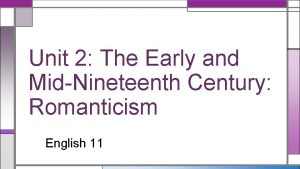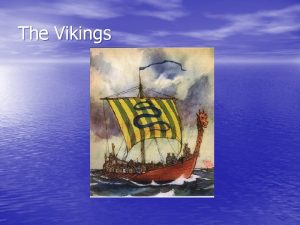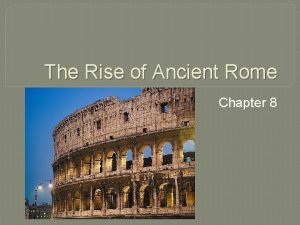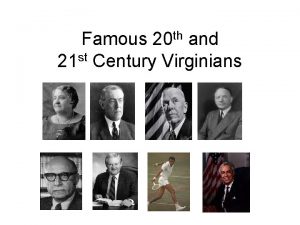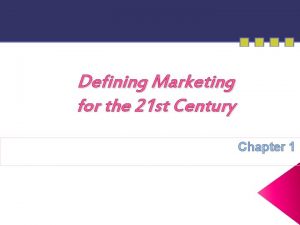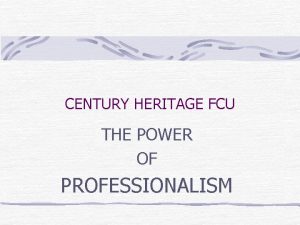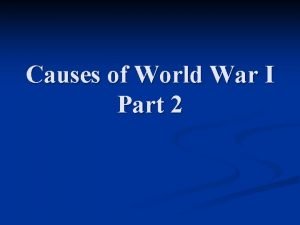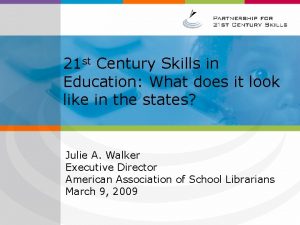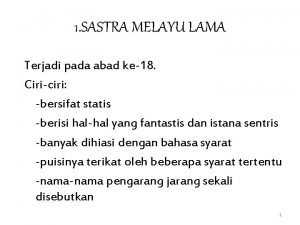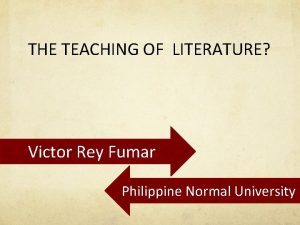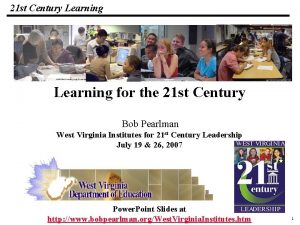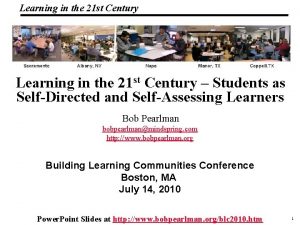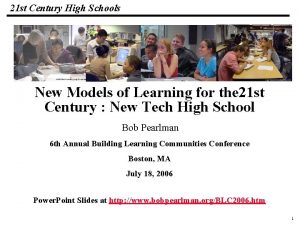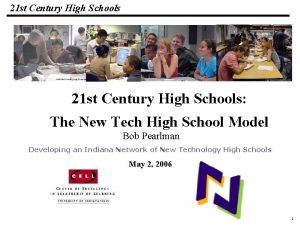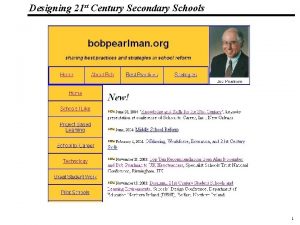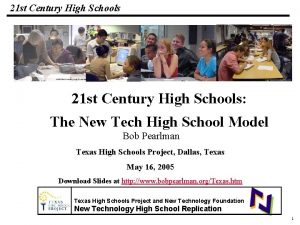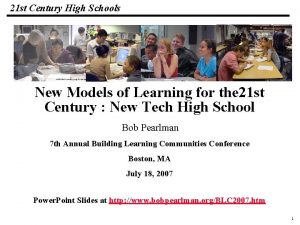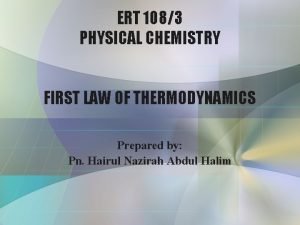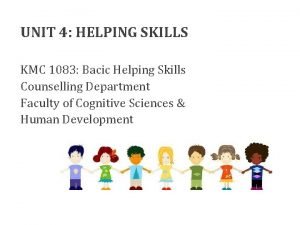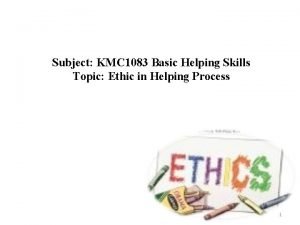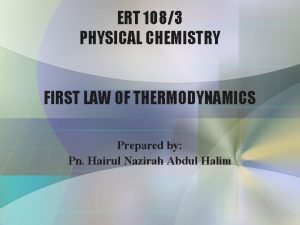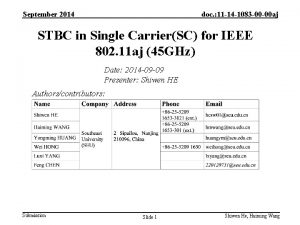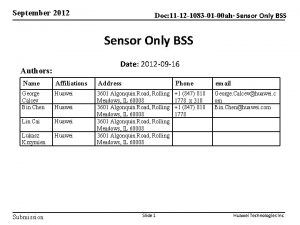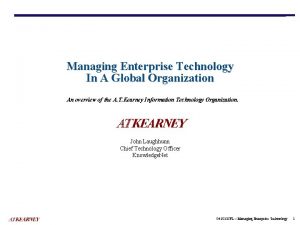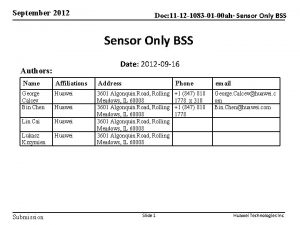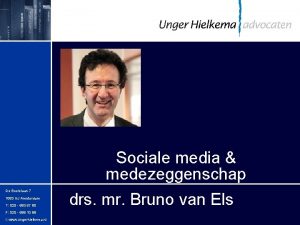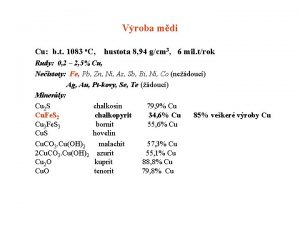Learning in the 21 st Century 19 1083























































- Slides: 55

Learning in the 21 st Century 19 1083 _Macros Learning in the 21 st Century – Students as Self-Directed and Self-Assessing Learners Bob Pearlman bobpearlman@mindspring. com http: //www. bobpearlman. org September 24 -25, 2009 Power. Point Slides at http: //www. bobpearlman. org/commcollege. htm 1

Learning in the 21 st Century 19 1083 _Macros Bob Pearlman Director of Education and Workforce Development, 2000 -2001 Joint Venture: Silicon Valley Network, San Jose, CA Director of Strategic Planning, 2002 -2009 New Technology Foundation, Napa, CA 2

Learning in the 21 st Century 19 1083 _Macros “We play a huge role in getting students prepared for college who come in with skills below college level. If we could transform that group of students in America, that segment who are under-prepared from high school and that segment who enter community college and other institutions of higher education without the critical writing, reading, and thinking skills required for a college education and success in the workplace, we'll be doing a huge amount to move America forward. ” -- TC Record Voice, September 2009 3

Learning in the 21 st Century 19 1083 _Macros March 7, 2008 Community-College Educators Focus on Globalization By KARIN FISCHER http: //chronicle. com/article/Community-College-Educators/18749/ "Many skilled workers are coming out of our colleges trained for jobs that don't exist anymore, " said Paul A. Elsner, chancellor emeritus of the Maricopa County Community College District, in Arizona, in a speech. "We have lots of skilled workers, but do they have the right kinds of skills? " Mr. Elsner, who presented the results of a study by the American Association of Community Colleges examining community and technical colleges in two dozen countries, said institutions in some developing nations were particularly nimble in adapting new technologies and meeting changing needs of employers and employees. The challenge for American community colleges, he said, is to deliver the skills crucial to the new economy — such as analytical thinking and the ability to work across cultural boundaries — to the widest possible range of workers. Two-year colleges can play a "democratizing" role, Mr. Elsner said. "We have to figure out how everybody gets access to those skills. " Paul A. Elsner, Chancellor emeritus of the Maricopa County Community College District, in Arizona 4

Learning in the 21 st Century 19 1083 _Macros What knowledge and skills do students need for the 21 st Century? 5

Learning in the 21 st Century 19 1083 _Macros SCANS U. S. Department of Labor Secretary's Commission on Achieving Necessary Skills COMPETENCIES - Effective workers can productively use: n Resources - allocating time, money, materials, space and staff. n Interpersonal Skills - working on teams, teaching others, serving customers, leading, negotiating, and working well with people from culturally diverse backgrounds. n Information - acquiring and evaluating data, organizing and maintaining files, interpreting and communication, and using computers to process information. n Systems - understanding social, organizational and technological systems, monitoring and correcting performance, and designing or improving systems. n Technology - selecting equipment and tools, applying technology to specific tasks, and maintaining and troubleshooting technologies. FOUNDATIONS - Competence requires: n Basic Skills - reading, writing, arithmetic and mathematics, speaking and listening. n Thinking Skills - thinking creatively, making decisions, solving problems, seeing things in the mind's eye, knowing how to learn, and reasoning. n Personal Qualities - individual responsibilities, self-esteem, sociability, self-management, and integrity. 1992 6

Learning in the 21 st Century Assessment of 21 st Century Skills Partnership for 21 st Century Skills http: //www. 21 stcenturyskills. org 19 1083 _Macros 7

Learning in the 21 st Century 19 1083 _Macros 21 ST CENTURY SKILLS DEFINED LIFE & CAREER LEARNING & INNOVATION n Creativity & Innovation n Flexibility & Adaptability n Critical Thinking & Problemsolving n Initiative & Self-direction n Social & Cross-cultural Skills n Productivity & Accountability n Leadership & Responsibility n Communication & Collaboration INFORMATION & TECHNOLOGY n Information Literacy n Media Literacy n ICT Literacy Partnership for 21 st Century Skills http: //www. 21 stcenturyskills. org 8

Learning in the 21 st Century 19 1083 _Macros Does your college have any kind of college-wide learning outcomes? 9

Learning in the 21 st Century 19 1083 _Macros expected schoolwide learning results 10

Learning in the 21 st Century 19 1083 _Macros COMMUNICATION CRITICAL THINKING & PROBLEM SOLVING GLOBAL AWARENESS & CULTURAL COMPETENCE INFORMATION AND TECHNOLOGY LITERACY QUANTITATIVE LITERACY SCIENTIFIC LITERACY PERSONAL RESPONSIBILITY & DEVELOPMENT 11

Learning in the 21 st Century 19 1083 _Macros New Technology HS LEARNING OUTCOMES Sacramento 10 Learning Outcomes: 1. Content Proficient 2. Able to Write Proficiently 3. Orally Proficient 4. Able to Think Critically 5. Technologically Proficient 6. Able to Collaborate • CRITICAL THINKING 7. Prepared for a Career • ORAL COMMUNICATION 8. Solid Citizens with Ethical Behavior • Written Communication 9. Able to Analyze and deal with Data 10. Possessing a solid Work Ethic Napa 8 Learning Outcomes • TECHNOLOGY LITERACY • COLLABORATION • Career Preparation • Citizenship and Ethics • Curricular Literacy (Content Standards) 12

Learning in the 21 st Century 19 1083 _Macros So what does learning look like where students get 21 st Century Knowledge and Skills? 13

Learning in the 21 st Century 19 1083 _Macros Watch Video and List Key Elements of this Teaching and Learning Practice: 1. _________________________ 2. _________________________ 3. _________________________ 4. _________________________ 5. _________________________ 6. _________________________ 7. _________________________ 14

Learning in the 21 st Century 19 1083 _Macros Monkey Trial Project Overview http: //www. youtube. com/watch? v=E 3 YZHPWJc-w&feature=Play. List&p=CC 8 AC 8985 C 7 E 6 FC 6&index=0 15


Learning in the 21 st Century 19 1083 _Macros Project- and Problem-Based Learning Keys to 21 st Century Learning Teachers start each unit by throwing students into a realistic or real-world project that both engages interest and generates a list of things the student need to know. Projects are designed to tackle complex problems, requiring critical thinking. The strategy for 21 st Century Learning is simple: n To learn collaboration, work in teams. n To learn critical thinking, take on complex problems. n To learn oral communication, present. n To learn written communication, write. n To learn technology, use technology. n To develop citizenship, take on civic and global issues. n To learn about careers, do internships. n To learn content, research and do all of the above. 17

Learning in the 21 st Century 19 1083 _Macros Each unit begins when students are presented with a complex, standards-based problem Students form a team, develop a work contract and build a work plan 18

Learning in the 21 st Century 19 1083 _Macros Students get to work! Students are provided an online briefcase specific to the project with information, resources, links and assessment criteria that help guide them. 19

Learning in the 21 st Century 19 1083 _Macros Students Need To Know Student questions and “need to knows” drive classroom lectures and activities. Sometimes for the whole class … sometime for just one student 20

Learning in the 21 st Century 19 1083 _Macros Students experiment and apply learning Students test their ideas and experiment to find solutions and breakthroughs while receiving ongoing feedback from instructors. 21

Learning in the 21 st Century 19 1083 _Macros Students get back to work! Students work and collaborate in a business-like environment, where they know their deliverables and have the technology tools to do their jobs. 22

Learning in the 21 st Century 19 1083 _Macros Students prepare to present Students work on building presentations to represent their work and defend their solutions 23

Learning in the 21 st Century 19 1083 _Macros Students present their solutions! Students present ideas through debates, skits, panels, presentations, etc… where their work is evaluated by peers, teachers, parents, and community 24

Learning in the 21 st Century 19 1083 _Macros The project drives the curriculum by creating a need for the students to know the content. Students work more autonomously on real or realistic work that has high stakes. Evaluation is made more authentic with performance based measurements and is often conducted with the help of non-teachers. 25

Learning in the 21 st Century 19 1083 _Macros Projects include: ------ Project Management Teamwork Presentation Exhibition Assessment and Feedback 26

Learning in the 21 st Century 19 1083 _Macros Getting to Self-direction 1. Provide students access to project materials PBL instruction is not as linear as traditional instruction. How can we organize our project materials for student access, action, self- direction, and project management? 27

Learning in the 21 st Century 19 1083 _Macros The Project Briefcase allows teachers to put all project materials in one spot for easy student access and to share with other teachers. 28

Learning in the 21 st Century 19 1083 _Macros They include everything from the entry document that launches the project to the rubrics used to assess the student’s performance. 29

Learning in the 21 st Century 19 1083 _Macros Getting to Self-direction 2. Provide students with a project calendar, benchmarks and deadlines 30

Learning in the 21 st Century 19 1083 _Macros The Course Agenda helps keep complicated projects organized. 31

Learning in the 21 st Century 19 1083 _Macros Teachers enter activities for each day including links to resources and homework assignments. 32

Learning in the 21 st Century 19 1083 _Macros Getting to Self-Assessment How can we help students become critical and engaged self-assessors of their own progress? 33

Learning in the 21 st Century 19 1083 _Macros 1. Assess Students on what students value New Tech HS LEARNING OUTCOMES • TECHNOLOGY LITERACY • COLLABORATION • CRITICAL THINKING INSTITUTIONAL LEARNING OUTCOMES COMMUNICATION CRITICAL THINKING & PROBLEM SOLVING GLOBAL AWARENESS & CULTURAL COMPETENCE • ORAL COMMUNICATION INFORMATION AND TECHNOLOGY LITERACY • Written Communication QUANTITATIVE LITERACY • Career Preparation SCIENTIFIC LITERACY • Citizenship and Ethics PERSONAL RESPONSIBILITY & DEVELOPMENT • Curricular Literacy (Content Standards) COLLECTIVE LEARNING OUTCOMES 34

Learning in the 21 st Century 19 1083 _Macros 2. Let Students see their grades 24/7 35

Learning in the 21 st Century 19 1083 _Macros 36

Learning in the 21 st Century 19 1083 _Macros A REPORT CARD THAT MATTERS When checking grades online, students see course grades and 21 st Century skill assessments. � 37

Learning in the 21 st Century 19 1083 _Macros 3. Let students see the grading criteria (rubrics) 38

Learning in the 21 st Century 19 1083 _Macros 39

Learning in the 21 st Century 19 1083 _Macros 40

Learning in the 21 st Century 19 1083 _Macros 41

Learning in the 21 st Century 19 1083 _Macros 42

Learning in the 21 st Century 19 1083 _Macros 4. Have Students demonstrate their mastery n. Products n. Presentations ne. Portfolios 43

Learning in the 21 st Century 19 1083 _Macros The portfolios are as diverse as the student body but with similar layouts and organization to aid in evaluation by staff and community members. 44

Learning in the 21 st Century 19 1083 _Macros 45

Learning in the 21 st Century 19 1083 _Macros CHALLENGE How can we better hold students accountable for their collaboration skills while working in a group? And how can students have collaboration evidence to put on their portfolios? 46

Learning in the 21 st Century 19 1083 _Macros At the end of each project, students evaluate their group members using this collaboration rubric database. 47

Learning in the 21 st Century 19 1083 _Macros Students submit evaluations using a standardized rubric for the whole school. 48

Learning in the 21 st Century 19 1083 _Macros Students can view how their peers rated them (although the evaluations are anonymous). Teachers can view, edit, and delete evaluations as necessary. They can also print a report that averages the evaluations for a given project. 49

Learning in the 21 st Century 19 1083 _Macros The evaluations are accessible on the web. Students have the option to “publish” the evaluations for use as evidence of their collaboration skills. This is the key to allowing students to demonstrate their performance of our learning outcomes. 50

Learning in the 21 st Century 19 1083 _Macros CHALLENGE How can we capture evidence for skills such as Oral Communication so that students have something to put on their portfolios? 51

Learning in the 21 st Century 19 1083 _Macros The evaluations are accessible from the web after the student has marked the evaluation “public”. 52

Learning in the 21 st Century 19 1083 _Macros The Presentation Database is a place to record and display evaluations of student performance on presentations. Collecting data on our learning outcomes is critical for the student’s Professional Portfolio. 53

Learning in the 21 st Century 19 Key recommendations n Determine the college’s Institutional Learning Outcomes (21 st Century Skills) n Embed the Learning Outcomes into projects n Design assessments to measure Outcomes n Students prove mastery of Learning Outcomes through Products, Presentations, and Portfolios n Provide students with just-in-time assessment feedback • Do it collegewide! 1083 _Macros Learning Outcomes Projects Assess 21 st Century Skills Products Presentations Portfolios Skills-Based Grade Reports 54

Learning in the 21 st Century 19 1083 _Macros Contact Information Bob Pearlman 21 st Century School Development Consultant bobpearlman@mindspring. com www. bobpearlman. org 520 -881 -9965 Power. Point Slides at www. bobpearlman. org/commcollege. htm 55
 Cuadro comparativo de e-learning
Cuadro comparativo de e-learning Hình ảnh bộ gõ cơ thể búng tay
Hình ảnh bộ gõ cơ thể búng tay Lp html
Lp html Bổ thể
Bổ thể Tỉ lệ cơ thể trẻ em
Tỉ lệ cơ thể trẻ em Gấu đi như thế nào
Gấu đi như thế nào Glasgow thang điểm
Glasgow thang điểm Chúa yêu trần thế alleluia
Chúa yêu trần thế alleluia Các môn thể thao bắt đầu bằng tiếng đua
Các môn thể thao bắt đầu bằng tiếng đua Thế nào là hệ số cao nhất
Thế nào là hệ số cao nhất Các châu lục và đại dương trên thế giới
Các châu lục và đại dương trên thế giới Công thức tính thế năng
Công thức tính thế năng Trời xanh đây là của chúng ta thể thơ
Trời xanh đây là của chúng ta thể thơ Cách giải mật thư tọa độ
Cách giải mật thư tọa độ 101012 bằng
101012 bằng Phản ứng thế ankan
Phản ứng thế ankan Các châu lục và đại dương trên thế giới
Các châu lục và đại dương trên thế giới Thể thơ truyền thống
Thể thơ truyền thống Quá trình desamine hóa có thể tạo ra
Quá trình desamine hóa có thể tạo ra Một số thể thơ truyền thống
Một số thể thơ truyền thống Cái miệng nó xinh thế chỉ nói điều hay thôi
Cái miệng nó xinh thế chỉ nói điều hay thôi Vẽ hình chiếu vuông góc của vật thể sau
Vẽ hình chiếu vuông góc của vật thể sau Thế nào là sự mỏi cơ
Thế nào là sự mỏi cơ đặc điểm cơ thể của người tối cổ
đặc điểm cơ thể của người tối cổ V cc cc
V cc cc Vẽ hình chiếu đứng bằng cạnh của vật thể
Vẽ hình chiếu đứng bằng cạnh của vật thể Tia chieu sa te
Tia chieu sa te Thẻ vin
Thẻ vin đại từ thay thế
đại từ thay thế điện thế nghỉ
điện thế nghỉ Tư thế ngồi viết
Tư thế ngồi viết Diễn thế sinh thái là
Diễn thế sinh thái là Các loại đột biến cấu trúc nhiễm sắc thể
Các loại đột biến cấu trúc nhiễm sắc thể Số nguyên tố là số gì
Số nguyên tố là số gì Tư thế ngồi viết
Tư thế ngồi viết Lời thề hippocrates
Lời thề hippocrates Thiếu nhi thế giới liên hoan
Thiếu nhi thế giới liên hoan ưu thế lai là gì
ưu thế lai là gì Hươu thường đẻ mỗi lứa mấy con
Hươu thường đẻ mỗi lứa mấy con Sự nuôi và dạy con của hổ
Sự nuôi và dạy con của hổ Hệ hô hấp
Hệ hô hấp Từ ngữ thể hiện lòng nhân hậu
Từ ngữ thể hiện lòng nhân hậu Thế nào là mạng điện lắp đặt kiểu nổi
Thế nào là mạng điện lắp đặt kiểu nổi Which two sentences contain a restrictive clause?
Which two sentences contain a restrictive clause? How to read timelines
How to read timelines Helvetica arial
Helvetica arial Vikings land
Vikings land Roman empire in first century
Roman empire in first century Famous virginians 21st century
Famous virginians 21st century Defining marketing for the 21st century
Defining marketing for the 21st century Adaptitude
Adaptitude Century ecosystem model
Century ecosystem model British empire 20th century
British empire 20th century St century
St century Poetry in 18th century
Poetry in 18th century It is a digital poetry that uses links and hypertext markup
It is a digital poetry that uses links and hypertext markup











































